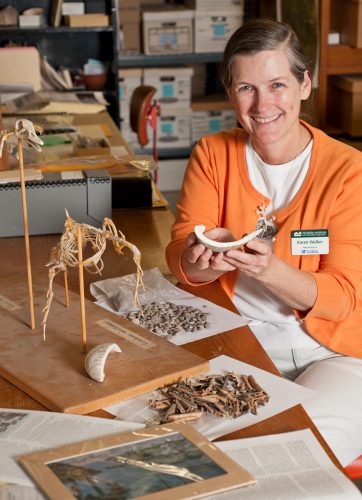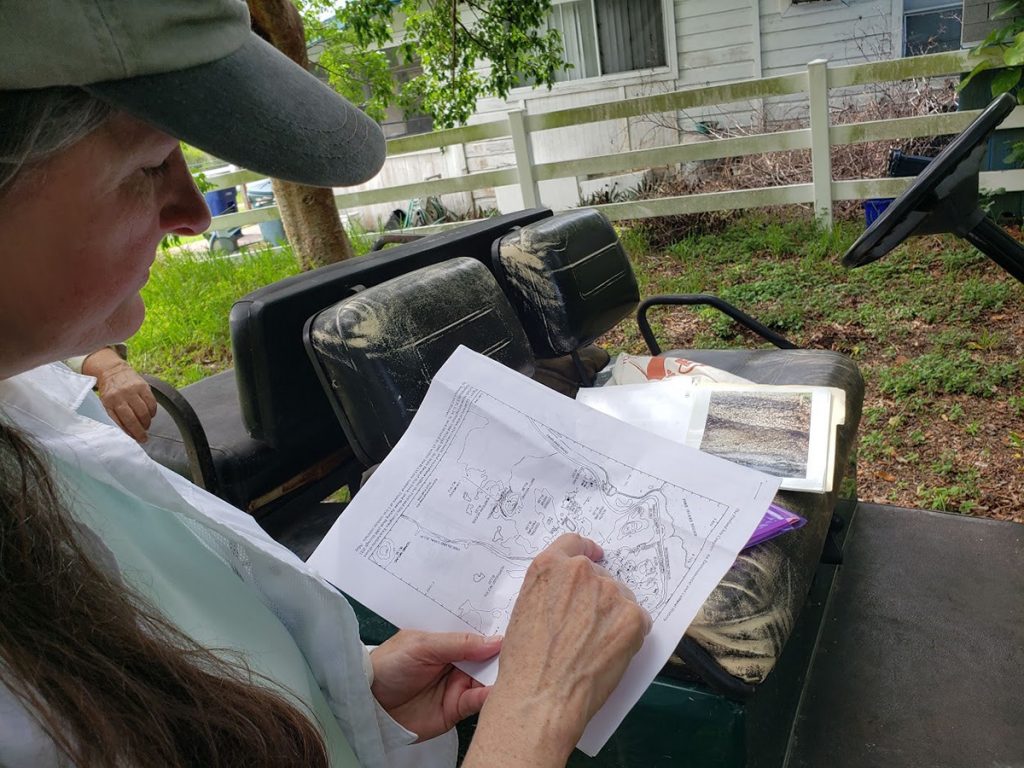As a way to honor Karen Walker after she retired last year, we asked her former colleagues to share their thoughts with us.
Mystery Solver and More
by Bill Marquardt
Karen Walker is a mystery solver. She has an intense curiosity about how things work and why they appear as they do. When she sees patterns in her data, she wants to know why, and how those patterns relate to others.
Some people think of Karen only as the collections manager for the Florida Museum’s South Florida Archaeology and Ethnography program, others only as the zooarchaeologist who analyzes the bones and mollusk shells from Pineland and other sites. Still others know her as the person best able to prepare and document shellmidden profiles that record important details of site histories. RRC volunteers know her as a co-founder of the Center and as a caring mentor and teacher who goes the extra mile to show how the smallest things we find can lead to some of the biggest revelations. Grad students at UF and elsewhere value her help and advice.

Walker displays a southern quahog clam
shell and other specimens from Pine
Island. Florida Museum photo by Kristen Grace
Karen has expanded zooarchaeology in southwest Florida to address broader questions about climate change, sea-level fluctuations, and cultural adaptations through time. Mollusk shells have been particularly important in this endeavor due to their sensitivity to environmental conditions including salinity an water temperature. (If Karen is the only zooarchaeologist you’ve ever met, it may surprise you to learn that some zooarchaeologists, even some prominent ones, don’t look at mollusk shells at all – just the bones.)
Partnering with geochemist Donna Surge, Karen was able to confirm subtle climate fluctuations by analyzing catfish otoliths and quahog clam shells from controlled archaeological contexts. Working with coastal geologist Frank Stapor, she helped shed light on barrier-island dynamics as they relate to sea-level changes. Teaming with geologist Mike Savarese, she helped document mass fish-capture techniques used by the Calusa at Mound Key. Under her sharp eyes, subtle clues to site abandonment and re-settlement as well as the timing of ancient storms have been revealed by paying attention to both land-snail and marine shells.
She systematically studied Florida coastal fishing artifacts, explaining how such items as compound fishhooks, bone points, and net mesh gauges worked, and showing that they compare well to fishing practices around the world. She compared fishing artifacts from within southwest Florida and related them to shallower- and deeper-water habitats. She has done field work throughout the eastern U.S. and even contributed to Florida pioneer history with her study of South Florida logging camps. She has written and edited major portions of our synthetic monographs, especially for Pineland, and is a prominent member of the interdisciplinary team currently researching Mound Key and environs.
Since 1988, Karen has devoted much of her energy and creativity to understanding and preserving the Pineland Site Complex and to establishing the Randell Research Center. I have learned a great deal from Karen and am privileged to have been her colleague for more than 35 years. Karen is looking forward to retirement, but I predict that we will see more studies and more publications from her in the future. There are still mysteries to solve, and she will not be able to resist.
Karen Jo is the consummate professional in every respect and a world-class scientist. I deeply appreciate and admire her meticulous approach, transdisciplinary research, and innovations in zooarchaeology, historical ecology, and paleoecology.
— Lee Newsom
Karen became a mentor to me
by Denége Patterson

I first met Karen Walker in 2000, at an excavation on Randell Complex Mound One.
During her work, Karen could profile every contour even while answering my questions. I learned how to examine every detail and to carefully leave artifacts in situ and not produce holes while profiling. She advised us to practice restraint when looking at artifacts, to avoid jumping to conclusions, and to wait for the lab work. I was inspired by her ethics and her wise experience.
I learned even more from Karen’s classes at RRC, from her published articles and displays, and especially from her co-edited 2013 book, The Archaeology of Pineland.
I was most influenced by her careful attention to the smallest of details, which together made a huge impact on ecosystems. I learned how tiny surprises and remarkable coincidences between both the living and the dead (and even fossilized creatures) do provide extremely precious data.
Karen’s work has set an example that “no living thing is trivial.” She has provided scientific evidence of climate changes going back thousands of years, allowing us to understand a trajectory of what is happening now to ecosystems around the world, and helping us to contemplate how living beings of all sizes and types are essential for restoring the balance—which is what this is all about. I will miss Karen.
Dedication to people and place – a force in southwest Florida
by Darcie MacMahon
Karen is synonymous with the RRC. She was instrumental in its founding, along with co-conspirator Bill Marquardt, and has been deeply engaged in its success ever since. Among her many contributions has been her commitment to the volunteer program, which has been such a vibrant aspect of the RRC. I have had the fortune to collaborate with Karen over the years, and especially appreciate her support as we developed the permanent exhibition on South Florida People & Environments for the museum in Gainesville. We all spent a lot of time at Pineland, and about six years developing the exhibition. And while we were at it, we developed the interpretive trail at Pineland. Karen’s research has led to important new insights on climate change and human history, so useful for thinking about past and future. And her careful, professional approach to curating the museum’s collection ensures that these materials will be available for future research. I am thankful for the time we have spent together – in the field, at the museum, and just having fun. This retirement is well deserved, and knowing Karen she will have a lovely time.
This article was taken from the Friends of the Randell Research Center Newsletter Vol 21, No. 1 & 2. November 2022.